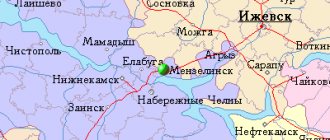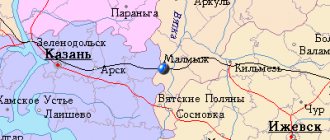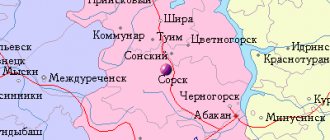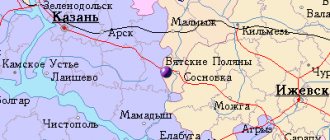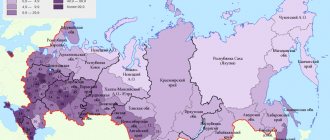Agryz
(Republic of Tatarstan)
OKATO code:
92201501
Founded:
1915
Urban settlement since:
1928
City since:
1938 City of district subordination (Agryz district of the Republic of Tatarstan)
Center:
Agryz district
Telephone code (reference phone)
| 85551***** | 32-2-41 |
Deviation from Moscow time, hours:
0
Geographic latitude:
56°31′
Geographic longitude:
53°00′
Altitude above sea level, meters:
90 Sunrise and sunset times in the city of Agryz
Links[edit]
Notes[edit]
- ^ abcde Order No. 01-02/9
- ^ abcd Encyclopedia of Russian Cities
. Moscow: Great Russian Encyclopedia. 2003. p. 13. ISBN 5-7107-7399-9. - ^ abc Federal State Statistics Service (2011). “All-Russian Population Census 2010. Volume 1" [All-Russian Population Census 2010, vol. 1]. All-Russian Population Census 2010 [All-Russian Population Census 2010]
. Federal State Statistics Service. - "26. The size of the permanent population of the Russian Federation by municipalities as of January 1, 2021". Federal State Statistics Service. Retrieved January 23, 2021.
- ^ abcde Law No. 14-ZRT
- "On the Calculation of Time". Official Internet portal of legal information
. June 3, 2011. Retrieved January 19, 2021. - Post office. Information and computing center of OASU RPO. ( Post office
).
Search for postal service objects ( postal Search for objects
) (in Russian) - ↑
Federal State Statistics Service of Russia (May 21, 2004).
“The population of Russia, the constituent entities of the Russian Federation as part of federal districts, urban settlements, settlements, settlements of 3 thousand or more people” [Population of Russia, its federal districts, federal districts, districts, urban settlements, rural settlements - administrative centers and rural settlements with a population of more than 3,000 people] (XLS). All-Russian Population Census of 2002 [All-Russian Population Census of 2002]
. - “All-Union Population Census of 1989. The current population of union and autonomous republics, autonomous regions and districts, territories, negative phenomena, urban settlements and rural district centers” [All-Union Population Census of 1989: current population of union and autonomous republics, Autonomous regions and districts , territories, regions, districts, towns and villages performing the functions of district administrative centers. All-Union Population Census of 1989 [All-Union Population Census of 1989]
.
Institute of Demography of the National Research University: Higher School of Economics [Institute of Demography of the National Research University: Higher School of Economics]. 1989 - via Demoscope Weekly
. - “All-Union Population Census of 1979. National composition of the population by regions of Russia” [All-Union Population Census of 1979. Ethnic composition of the population by regions of Russia] (XLS). All-Union Population Census of 1979 [All-Union Population Census of 1979]
.
1979 - via Demoscope Weekly
(website of the Institute of Demography of the State University - Higher School of Economics. - A.V. Altyntsev (A.V. Altyntsev). “The feeling of love in the understanding of Ashkenazi Jews of Udmurtia and Tatarstan. Archived March 21, 2017, at the Wayback Machine" ( The concept of love as understood by Ashkenazi Jews in Udmurtia and Tatarstan
). "Science of Udmurtia", No. 4 (66), 2013 (in Russian)
Map
| Agryz: maps |
Agryz: photo from space (Google Maps) Agryz: photo from space (Microsoft Virtual Earth)
| Agryz. Nearest cities. Distances in km. on the map (in brackets along roads) + direction. Using the hyperlink in the distance , you can get the route (information courtesy of the AutoTransInfo website) | |||
| 1 | Malaya Purga (Udmurt Republic) | 3 (4) | WITH |
| 2 | Kiyasovo (Udmurt Republic) | 20 (44) | YU |
| 3 | Zavyalovo (Udmurt Republic) | 38 (50) | NE |
| 4 | Izhevsk | 39 (36) | WITH |
| 5 | Khokhryaki (Udmurt Republic) | 48 () | NE |
| 6 | Mozhga | 48 (58) | Z |
| 7 | Sigaevo (Udmurt Republic) | 48 (73) | IN |
| 8 | Sarapul | 49 (66) | IN |
| 9 | Alnashi (Udmurt Republic) | 49 (95) | SW |
| 10 | Novy (Udmurt Republic) | 70 () | NE |
| 11 | Vavozh (Udmurt Republic) | 71 (104) | NW |
| 12 | Uva (Udmurt Republic) | 71 (114) | NW |
| 13 | Karakulino (Udmurt Republic) | 71 (122) | SE |
| 14 | Yakshur-Bodya (Udmurt Republic) | 73 (81) | WITH |
| 15 | Chaikovsky | 75 (132) | IN |
| 16 | Kambarka | 78 (95) | IN |
| 17 | Mendeleevsk | 80 (112) | SW |
| 18 | Grakhovo (Udmurt Republic) | 82 (135) | SW |
| 19 | Nikolo-Beryozovka (Republic of Bashkortostan) | 83 (120) | SE |
| 20 | Votkinsk | 85 (95) | NE |
| 21 | Agidel | 89 (168) | SE |
| 22 | Menzelinsk | 89 (204) | YU |
| 23 | Neftekamsk | 90 (128) | SE |
| 24 | Amzya (Republic of Bashkortostan) | 90 (152) | IN |
| 25 | Kizner (Udmurt Republic) | 94 (136) | Z |
| 26 | Naberezhnye Chelny | 94 (147) | SW |
| 27 | Sharkan (Udmurt Republic) | 101 (124) | NE |
| 28 | Elabuga | 102 (134) | SW |
| 29 | Selty (Udmurt Republic) | 102 (154) | NW |
| 30 | Syumsi (Udmurt Republic) | 106 (183) | NW |
a brief description of
Located at the foot of the Sarapul Upland, on the banks of the river. Izh (Agryzka ??) (Volga basin). Railway node
Territory (sq. km): 58
Information about the city of Agryz on the Russian Wikipedia site
Historical sketch
It was founded as a village at the Agryz station (opened in 1915) in connection with the construction of the Kazan-Ekaterinburg railway. Name by river Agryz (etymology not established).
Since 1924 it has been a provincial town, in 1926 it was excluded from the list of cities, and since March 20, 1928 it has been a town. On August 28, 1938 it was transformed into a city.
Economy
Railway maintenance enterprises node. Construction materials plant. Forestry Raipchekombinat.
In the Agryz region, rye, wheat, oats, and buckwheat are grown. Cattle and sheep are raised.
Oil fields.
Museums, galleries, exhibition halls
Museum of History of the Agryz District 422200, Republic of Tatarstan, Agryz district, Agryz, st.
Karl Marx, 26 Museum of the History of the Village of Salaush 422290, Republic of Tatarstan, Agryzsky district, village. Salaushi
| Population by year (thousands of inhabitants) | |||||||
| 1931 | 5.3 | 1996 | 19.4 | 2008 | 18.9 | 2017 | 19.7 |
| 1939 | 15.4 | 1998 | 19.8 | 2010 | 19.2 | 2018 | 19.8 |
| 1959 | 20.3 | 2000 | 19.2 | 2011 | 19.3 | 2019 | 19.8 |
| 1967 | 20 | 2001 | 19.2 | 2012 | 19.6 | 2020 | 19.7 |
| 1970 | 19.3 | 2003 | 18.6 | 2013 | 19.7 | 2021 | 19.7 |
| 1979 | 20.1 | 2005 | 18.6 | 2014 | 19.8 | ||
| 1989 | 19.7 | 2006 | 18.6 | 2015 | 19.7 | ||
| 1992 | 19.4 | 2007 | 18.7 | 2016 | 19.7 | ||
Team Nomads
Agryz (Tat. Egerzhe) is a city of regional subordination in Russia, the administrative center of the Agryz district of Tatarstan.
Area 8.6 sq. km.
The city is located in the extreme northeast of Tatarstan, on the border with Udmurtia, at the foot of the Sarapul Upland, on the Agryzka River (a small tributary of the Izh River, Volga basin), 304 km east of Kazan and 36 km south of Izhevsk. The Sarapul Upland is a hill on the border of Udmurtia and Tatarstan, in the interfluve of the Kama and its right tributary Izha. The surface of the hill is heavily indented by ravines and river valleys.
There are almost no forest areas left. In the east and south, the hills descend steeply to the Kama, forming a steep bank with steep slopes. In the west, the hill ends with the high left bank of the Izh River. Population, people
1959 1970 1979 1989 2002 2010
20 270 19 267 20 137 19 732 18 620 19 157
According to the 1989 census - Tatars - 50.1%, Russians - 38.6%, Udmurts - 7.2%.
This area is notable for the fact that it is home to the largest number of Mari and Udmurts (Finno-Ugric peoples) of all the regions of Tatarstan.
City of Agryz History
Known since 1646.
At the beginning of the 20th century, a volost government was located in Agryz, there was a school and 2 mosques. During the Izhevsk-Votkinsk uprising, Agryz was occupied by Izhevsk rebels, and until the end of October 1918 there were heavy battles in the city and its environs. Until 1920, the center of the Agryz volost of the Sarapul district of the Vyatka province.
Since 1921 the center of the Agryz canton of the TASSR, since 1924 a provincial town, subordinate to the Yelabuga canton executive committee. In 1926 it was excluded from the list of cities; on February 14, 1927 it became the administrative center of the Agryz region. In 1928 it was classified as a workers' settlement; on August 28, 1938 it was transformed into a city of regional subordination.
From January 1, 1963, due to a change in the administrative-territorial division of the TASSR, it was administratively subordinate to the Yelabuga City Council; from March 4, 1964, it was again a district center.
An important junction of railway lines to Kazan, Yekaterinburg, Izhevsk, Akbash. Railway workshops, a building materials plant, a butter and dairy plant, a grain receiving plant, a printing house, a food processing plant. 4 secondary schools, a children's music school, a vocational school, an ice palace, a local history museum, a central regional hospital, a railway hospital. 2 mosques. Interesting Facts
On the night of June 3, 2011, as a result of explosions at a military arsenal near the village of Pugachevo, Malopurginsky district of the Udmurt Republic, the city of Agryz was almost completely evacuated. Famous natives and residents of the city
Abdrakhmanov, Asaf Kutdusovich (1918-2000) - sailor, Hero of the Soviet Union. Farrakhov, Airat Zakievich (b. 1968) - Minister of Health of the Republic of Tatarstan. Khalikov, Ildar Shafkatovich (b. 1967) - Prime Minister of Tatarstan.
ARTICLE ABOUT THE CITY OF AGRYZ
The city is like people. Everyone has their own face. Agryz is a city of railway workers, a city of workers. He wakes up and falls asleep to the clatter of carriage wheels and the rumble of heavy trains. There is a station, locomotive and carriage depots, track distances, signaling and communications. Transit trains pass through Agryz station around the clock in four directions. Although our city is small, it has a glorious history, since 364 years have passed since its founding, and 72 years have passed since it was given the status of a city. During this period, when Agryz became a city, great changes took place in its life.
In the distant past, Agryz, a small typical Tatar village with crooked and dirty streets, was located in a picturesque area near the mouth of the Agryzka River, which flows into the Izh River. The village was surrounded on all sides by forests: on the left bank of the Izh there was taiga, from the north and north-west there were swamps, and on the elevated areas there grew oak forest and hazel trees, some of which are still preserved in the vicinity of the western part of the city. The Tatars settled here, having left Kazan and the surrounding territories, fleeing the troops of Ivan IV the Terrible. In this way the settlement of Agryz arose.
There are several legends about the origin of the name “Agryz-Agerzhe”.
One of them says that the resettlement of the Tatars to these places was led by brave and courageous brothers, one of whom was called Agerzhe. The settlement was named in honor of him.
It is likely that the name Agryz came from the Finno-Ugric languages, in particular from the Udmurt or Mari, since the Udmurts and Mari settled in these areas much earlier than the Tatars. As you know, geographical names are very tenacious, and very often they outlive the people who came up with the name.
According to documentary data from the Central State Archive of Ancient Acts in Moscow, the village of Agryz was first mentioned as part of the estates belonging to the Yaushev princes in the Tersinskaya volost in the census books of 1646. At that time there were only six courtyards. Since Agryz was first mentioned in the census books of 1646, there is every reason to consider this year as the beginning of the founding of the settlement of Agryz-Agerzhe.
In 1775, Agryz and the territory of the current Agryz municipal district were included in the Sarapul district of the Vyatka province. By the beginning of the twentieth century, Agryz had become a large village with 667 households. There was one primary school, but there was no hospital, not even a simple paramedic station, and there were no cultural institutions. But there were three mosques. The development of Agryz began during the construction of the Kazan-Ekaterinburg railway. Agryz city
In 1918, the first Soviet school opened, located on Lesopilnaya Street. There was a school for Tatar children on Sovetskaya Street. Medical care for the population improved. A paramedic station has opened. With the formation of the TASSR, Agryz, which was part of the Vyatka province for a century and a half, became part of it. 1921 - Agryz canton was formed.
In 1924, the Agryz canton was transformed into the Agryz region, and its borders were determined. Agryz became a regional center. 1929 - an entire medical town came into operation - a railway hospital with surgical, therapeutic, and maternity departments. A new high school building was built. Shops, canteens and bakeries were built.
1928 - The Agryz collective farm was formed, called “Kyzyl Yoldyz” - “Red Star”. In 1958, on the basis of a collective farm, livestock farm and a small state farm, a powerful state agricultural enterprise was created - the Agryzsky fattening state farm. The end of the 20s - the village of Agryz turned into a working settlement with a population of about 10 thousand people.
Under the leadership of the Agryz party organization, the appearance of Agryz and its people changed. On August 28, 1938, the working village of Agryz was renamed the city of Agryz by Decree of the Presidium of the Supreme Soviet of the RSFSR.
1941-1945 —
the years of the Great Patriotic War, when the heroic work of fellow countrymen played a big role in the cause of the great Victory. The Agryz railway junction, which connected the military-industrial base of the Urals with the front during the war, made a worthy contribution to the history of the Great Patriotic War.
Like the entire Soviet people, the Agryz people took an active part in the defeat of fascism and the restoration of the national economy destroyed by the war. The end of the 50s was marked at the junction by the replacement of steam locomotive traction with diesel locomotive traction.
Due to the introduction of diesel locomotive traction, the volume of transportation in the 60s compared to 1946 increased by 5.5 times, the average daily mileage doubled. 1961 - two roads were merged - Gorkovskaya and Kazanskaya into one - Gorkovskaya railway, the length of which is more than 5 thousand km. February 1, 1963 - Agryzsky district was abolished with the transfer of the territory to the Elabuga region. March 4, 1964 – Agryz district was restored.
60s - a movement for communist labor developed in the country, which spread throughout the region. In connection with the unfolding competition for communist labor in 1986, 15.7 million tons of cargo were transported at the hub in excess of the norm, and 4.5 million rubles in profit were received.
1975 – Natural gas was lit for the first time in the area. Blue fuel was the first to arrive at houses No. 2 and No. 4 on the street. K. Marx. In 1993, gasification of villages began. Commissioned: 1963 – boarding school. 1965 – building of the Republic of Kazakhstan CPSU. 1969-1973 – academic building and dormitory of SGPTU-27.
1968 – building of secondary school No. 74.
1970 - railway sorting post office. 1970 – consumer services plant. 1974 – the southern part of the city is connected to the northern road overpass. 1975 – kindergarten-nursery for 140 places. 1975 – “Yunost” dormitory for 360 places.
1977 – regional communications center. 1977 – Palace of Culture for Railway Workers with 600 seats. 1978 – shopping center. 1980 – construction of the new Agryz-Krugloye Pole line was completed. This provided a direct connection between the Kama Automobile Plant and the industrial regions of the Urals and Center.
Along this legendary line, the Nomadic Team made legendary trips to the Urals!
June 19, 1981 - opening of the square named after. IN AND. Lenin, where a monument to the leader of the people V.I. was erected. Lenin. 1987 – SMP-184 dormitory for 432 places, bank building, savings banks, hotels, district council building. December 14, 1983 – electrification of the Agryz-Yanaul section was completed.
May 9, 1985 - opening of the Victory Square and the Victory Monument to the Agryz soldiers of the Great Patriotic War of 1941-1945.
2002 - on the basis of the carriage depot of the station. Agryz built the first network maintenance point in Russia for the processing of wagons. 2003 – the station was reconstructed and updated. 2004 – the Dilapidated Housing program was completed.
2005 - a new building of city secondary school No. 3 was built. 2005 - the Nur mosque was built. 2005 - the implementation of the Social Mortgage program began. 2006 - the Palace of Culture was reconstructed and updated.
COLLECTIVE ENTERPRISE “INTERNATIONAL” – FROM THE HISTORY OF THE CITY OF AGRYZ
In 1927, on the territory of the former Agryz state farm, an artel for cultivating the land was organized, which included 10 Agryz families. Each member of the artel donated horses, cows, carts, plows, etc. to its fund. Batyrshin Gabdulkhak was elected chairman of the artel. In 1930, due to the increase in artel members, it was reorganized into a collective farm called “Kyzyl Yulduz”. Nurmukhamat Zakirov was elected chairman. A party group was organized, and Safiullina Nagima was elected party secretary. A women's council was created to work with women, and Rakiya Basarievna Chernysheva was elected chairman. The collective farm board was located in the old kulak house. During these years, stables and cowsheds were built, and a vegetable plot was created. Safiullin Mullayan worked as an agronomist during these years.
Three brigades worked under the leadership of Ibragimov Salei, Mukaev Mukhametzyan, Yapparov Gabdrakhman. Nafikov Lutfulla and Shamsutdinov Zahit worked as storekeepers. Over time, the collective farm was renamed “III International”. The collective farm was engaged in poultry farming, vegetable growing, fur farming (fur farming), and animal husbandry (there was a dairy farm). In 1935-36. 4 collective farms (“Igenche”, named after Kaganovich, named after Stalin, “III International”) had 3 tractors. Valeeva Taifa worked as a livestock breeder almost around the clock, seven days a week. The first tractor driver was a woman - Asiya Vagapova.
Shlyapin Gabdrakhman also worked as a tractor driver with her. The car depot patronized the collective farm, systematically providing practical assistance in repairing equipment and providing labor. In 1958, on the basis of the III International collective farm, a powerful state agricultural enterprise was created - the Agryzsky feeding state farm, which had 1,750 hectares of sown area, 18 tractors, 6 combines, 8 vehicles and many other agricultural implements. It had its own mechanized workshop for repairing equipment. Almost all labor-intensive work is mechanized. On the state farm, the most serious attention is paid to the life of the workers. The issue of housing is not a problem - everyone who goes to work is provided with apartments, has its own canteen, school, nursery for 50 places, kindergarten, store. For many years, until March 1970, the farm was led by the communist Leonid Pavlovich Yarkhunov. He was an energetic person who knew his job very well and skillfully organized the work of a large team of workers to carry out government tasks. Much of the credit for increasing productivity belonged to the chief agronomist of the state farm, Enikeev Khalil Sharifullovich.
After graduating from the Enikeev Agricultural Institute, Khalil came to Agryz and connected his entire hectic life with this city and its people. He devoted his knowledge, skill and energy to agriculture. Enikeev Kh. Sh., who worked at the state farm for more than 30 years, accumulated vast experience in agronomy. He was a tireless man. He worked hard to increase productivity and tried to introduce best practices. For his conscientious and honest work, he was awarded the high title of Honored Agronomist of the TASSR. A skilled organizer was the foreman of the complex brigade, R. Ishmanova, who worked at the state farm for many years. In 1965, livestock breeders also achieved good results in fattening livestock. The plan for average daily weight gain was exceeded, which made it possible to receive 381 thousand rubles in income. Much credit for this belonged to livestock specialist I. Semenova, pig farmers A. Kostenkova, T. Malinina, N. Danilova, Z. Nizamova, Kh. Khurmanova and others.
For the successes achieved in obtaining high yields, developing livestock and exceeding their obligations in honor of the 50th anniversary of the Great October Revolution, the team of the fattening state farm was awarded a memorial banner of the regional committee of the CPSU, the Supreme Council of the TASSR, the Council of Ministers of the TASSR and the regional Council of Trade Unions, and which was left for eternal storage, inspiring these glorious people to new labor feats.
Since March 1970, the Agryzsky state farm was headed by Khabibullin Ravil Gatievich, a native of the village of Salaushi. During this period, state farm production embarked on a further path of agricultural intensification. Chemicalization and land reclamation were widely used; liming and phosphorite treatment of fields. The application of organic fertilizers increased to 10 t/ha and mineral fertilizers to 170 kg per 1 ha of arable land.
All this contributed to increasing agricultural productivity. The material and technical base of the state farm has been strengthened. The mechanical park consisted of 15 cars, more than 20 tractors, 8 grain harvesters and potato diggers. Their repair and maintenance have improved. 2 closed parking lots for cars, tractors and a site for agricultural machinery were built. The state farm team has achieved further success in the development of livestock farming on the state farm and the procurement of livestock from farms in the region.
The state farm annually received and shipped 10-12 thousand heads of cattle, more than 15 thousand heads of pigs and sheep to the meat processing plants of the Tatar and Udmurt republics and the Sverdlovsk region. Every summer, more than 1,500 head of bulls and calves were kept for feeding in 4 open feedlots. Their average daily weight gain reached 800-900 grams. The number of fattening pigs sometimes reached up to 5 thousand heads, and their average daily weight gain was at least 500-550 grams.
The total volume of meat sales to the state was 450-500 tons per year. For the success achieved, director Khabibullin R.G. in 1976 he was awarded the Order of the Badge of Honor. In December 1977, Khabibullin RG. was transferred to work in the Tatar Regional Committee of the CPSU, then worked at various agricultural enterprises.
Ravil Gatievich’s career has been marked by many state awards. He was awarded the titles “Honored Worker of Agriculture” and “Laureate of the State Prize for Science and Technology of the Republic of Tatarstan” (2001), he was awarded orders and medals, and was repeatedly awarded the Certificate of Honor of the Supreme Council and the President of the Republic of Tatarstan.
Mosques and madrassas in Agryz
On February 1, 2012, an employee of the education department of the Muslim Spiritual Directorate of the Republic of Tajikistan took a trip to the regional center of Agryz. There are two mosques in the regional center of Agryz. The Hasan Mosque, which is located in the lower part of Agryz, and the Nur Mosque in the upper part. There is an elementary madrasah at the Nur mosque, in which over 100 students study. These are mostly older women. The madrasah is located next to the mosque in a separate two-story building. The madrasah is equipped with all the equipment necessary for the educational process (separate classes, teachers' room, etc.), but there is a shortage of educational literature.
Satellite television has been installed for viewing Arabic channels while learning Arabic. In the month of Ramadan, they show the performance of Tarawih prayers, and subsequently, as pilgrims in Mecca, they perform the Hajj. The madrasah teaches the main Islamic disciplines: aqidah, fiqh, Arabic and ahlak. The Nur Mosque is also equipped with everything necessary. In the women's hall there is a TV that broadcasts a picture from the main hall of the mosque. The Hasan Mosque also conducts Sunday teaching.
During the trip, a meeting was held with the head of the Agryz region, Gabbasov Farit Garifovich. The administration actively promotes and supports mosques and madrassas.
With the help of the administration of the Agryz region, the Nur madrasah was built.
Agryz.
Church of the Resurrection of Christ Orthodox Church. Valid. Thrones: Resurrection of Christ Year of construction: not earlier than 2005. Address: Agryz, st. Karl Marx, 86. Coordinates: 56.522003,52.993493 In 1995, the Orthodox community of the city of Agryz was given the building of the former people's court, consisting of a wooden frame built in 1928 and a brick extension from 1964.
A house of prayer was established in the building in honor of the Resurrection of Christ. In 2005, the foundation of a new stone temple was laid. Construction is being carried out with donations from parishioners and with the support of the district administration.
Currently, services in the prayer house are held on Sundays and holidays.
Museum of the History of Agryz District
Address: 422200, Republic of Tatarstan, Agryz, st. K. Marx, 26
Memorable dates and annual events: May 18 - International Museum Day Key officials:*
Director: Liliya Akhsanovna Suleymanova Directorate address: 422200, Republic of Tatarstan, Agryz, st. K. Marx, 26
_____________________________________________________________________________________
SOURCES OF INFORMATION AND PHOTOS:
Team Nomads.
https://agryz.tatarstan.ru/
https://agryzhotel.ru/
tour https://www.museum.ru/M2697images
https://islamio.ru/structure/agryz_district/mechet_nur_v_g_agryz/
https://temples.ru/show_picture.php
https://www.agryz-rt.ru/tt/gallery/category/
| The attachment | Size |
| 24.68 KB | |
| 94.84 KB | |
| 29.35 KB | |
| 51.16 KB | |
| 52.09 KB | |
| 41.05 KB | |
| 52.12 KB | |
| 80.04 KB | |
| 68.69 KB | |
| 33.64 KB | |
| 120.45 KB | |
| 40.77 KB |
